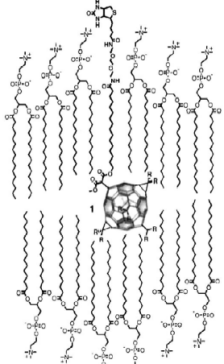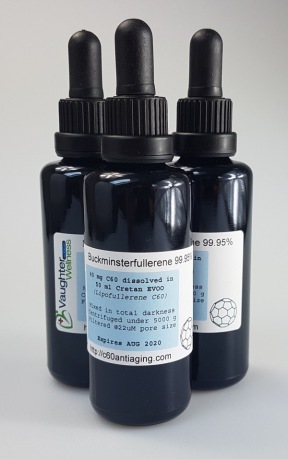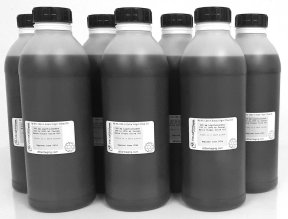C60 / Buckminsterfullerene: Side effects, toxicity?
People are understandably concerned about taking something that has only been discovered a few decades ago. Dr. Fathi Moussa, principal author of the C60 rat study is convinced C60 is non-toxic:
C60 in olive oil is anti-toxic: Lipofullerene C60 fully neutralizes lethal doses of certain toxic chemicals. Even better: Rats given a mere 24 doses of C60 oil lived 90% longer than the control group. Rats given otherwise lethal doses of an hepatotoxic chemical were fully protected by a prior single dose of C60 in olive oil. The photos of their healthy livers and the damaged livers of the rats that were not given C60 are in the study (PDF) on the left.
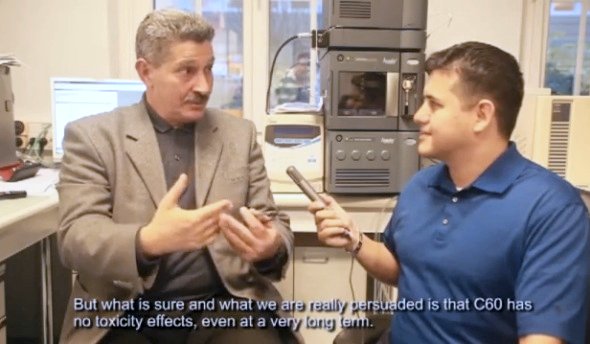
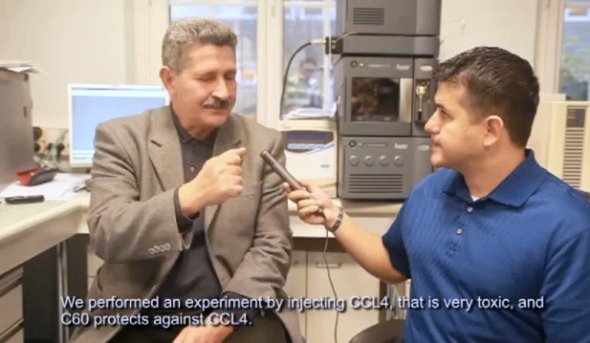
Vidcaps taken October 26, 2012. Source: C60.net. No restrictions applied at that time (post #13).
Dr. Moussa has no commerical interest in C60 and holds no C60 patents or C60-related shares.
Dr. Moussa has studied the effects of C60 on animals for 18 years when he made that statement. Some people hardly ever take any pills or supplements as a matter of principle, and I am one of those - with the exception of important medical treatment such as antibiotics, or supplements to help me recover from the flu. I believe in a healthy diet instead of eating food from depleted soils and supplementing with vitamins and minerals.
 After having talked this through with my husband and doing weeks of intensive literature research into fullerene (esp. C60) toxicity, we both have decided to start taking C60 on a daily basis, perhaps for the rest of our lives. A no-brainer, since it will be cheap for us, because we own the so far only "serious" production line. "Serious", as in sterilized bottles, staff with gloves and face masks, and manufacturing procedures performed in a way that we don't have to be ashamed when the authorities come knocking. Please understand that we in no way are allowed to endorse this product for human use, neither are we allowed to make any claims as to its beneficial effects on human health. We can discuss the data in research papers though.
After having talked this through with my husband and doing weeks of intensive literature research into fullerene (esp. C60) toxicity, we both have decided to start taking C60 on a daily basis, perhaps for the rest of our lives. A no-brainer, since it will be cheap for us, because we own the so far only "serious" production line. "Serious", as in sterilized bottles, staff with gloves and face masks, and manufacturing procedures performed in a way that we don't have to be ashamed when the authorities come knocking. Please understand that we in no way are allowed to endorse this product for human use, neither are we allowed to make any claims as to its beneficial effects on human health. We can discuss the data in research papers though.
C60 (The chemical name for Buckminsterfullerene AKA "buckyballs") is neither a food supplement nor a medicine. It is a natural substance found in small quantities in chimney soot, candle smoke and wood ashes, and although the pharmaceutical industry has often professed a strong interest in this spherical molecule, nothing worth mentioning in that regard has come out of their production lines so far. Infitesimal quantities of C60 are added to certain astronomically priced skin creams and to be honest, we doubt that the price is worth it.
Pure C60 in olive oil is therefore a mixture of two substances found in nature. It is true that C60 can only be economically produced using industrial methods, but the same goes for vitamin C.
There have been quite a few studies done on fullerene toxicity, and what they found was:
- Unmodified C60 can't dissolve in water, only be suspended. C60-oil mixtures are non-toxic, but C60-water mixtures or hydroxylated C60 are more or less toxic, although the toxicity of C60 nanoparticles in water can be fully prevented by adding vitamin C:
This is a study claiming toxicity of aggregated (undissolved lumps of) C60, please note that aggregated C60 has nothing to do with oil-dissolved and oil-bound molecular C60 (lipofullerenes). Aggregated C60 are lumps of C60 that float around in a liquid, they are not dissolved C60 molecules at all, let alone bound to lipid molecules as they are in C60 in olive oil. So those studies that talk about C60 toxicity do not imply toxicity of C60 in oil, since that is a chemically totally different product.
Fullerene toxicity exist, but only occurs when fullerenes lump into nanoparticles or crystallize into larger structures. This happens in watery solutions of fullerenes but has been proven to be impossible with lipofullerenes (C60 in oil). The lipid chains attached to the C60 molecule prevent clumping or crystallization:
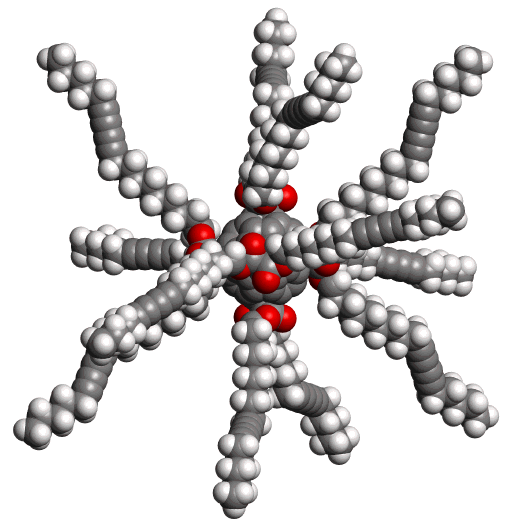
A lipofullerene of C60
Carbon nanotubes are suspected to have similar properties to asbestos fibers, and concern that some sources of C60 could theoretically contain traces of carbon nanotubes were alleviated by a study that found no traces of them in even the most impure commercial sources of C60.
Lipofullerenes are stable in the presence of water, so when you ingest C60 dissolved in oil it will never turn into C60 dissolved in water, since the affinity of the C60 molecule to lipids is very much higher than that to water.
- Some solvents used in fullerene purifcation are toxic, and have to be removed before producing any C60 consumables.
- C60 in oil (lipofullerene) is totally non-toxic and has shown "negative toxicity" (stronger growth and longer life) in several trials on lower as well as higher organisms. C60 dissolves in vegetable oils, although this takes a lot of stirring and patience, and not much of it dissolves. There have been quite a few studies done on oil-dissolved Buckminsterfullerene and none of them found any toxicity - on the contrary, it has a strong liver-protective effect, it protects against radioactivity (gamma radiation), a beneficial effect on cardiovascular health and lab rats lived nearly two years longer than the olive-oil only control group. That means that at least for rats, C60 in extra virgin olive oil has the highest "negative toxicity" of all substances known to man. Rats normally only live two, three years. And those C60 rats did not develop the tumors or pneumonia to which the control group eventually succumbed. Instead, the C60-in-oil rats simply died of the generalized deleterious effects of old age on their organ system. They hit in a way their "genetical maximum lifespan". This by itself would be a strong argument against any concerns of toxicity.
Additional studies confirm that C60 dissolved in oil is non-toxic. On the contrary, every study shows beneficial effects - whatever lifeform is used as a test subject: Fungi, small aquatic organisms, mice, rats. They live longer, are more resistant to age-related illness, the C60 has a liver-protective effect and brain function in old age is restored to the level of that of a young animal (mice study). C60 even prolongs the lifespan of mice with familial ALS and has a neuroprotective effect - not that we think that C60 will have any effect on any type of ALS - familial or sporadic. It does appear however, that C60 somehow performs a rejuvenating action somehow. There are many hypotheses as to what could be happening, and we will discuss those soon.
We initially thought that the centrifuging of the C60-oil solution in the rat study was done to make sure that no nano-particles of C60 ended up in the solution, but it turns out that not even centrifuging and micro-filtration can remove all of those. The good news is that toxicity trials show that C60 nanoparticles in oil are harmless. What the centrifuging and filtration does however, is to remove micro-particles. The filtration also removes all bacteria from the oil, since bacteria do not fit through a 0.22 micrometer hole. The rat study was a LD50 study, and the researchers wanted to avoid criticism oftheir methods, hence this meticulous preparation of the C60-olive oil solution, so that if toxicity would be found, that noone could claim that it could be due to microscopic C60 particles or even bacterial contamination, after two weeks of stirring.
More studies that show no C60-in-oil toxicity
Apart from the rat C60 LD50 study that turned into a rat C60 longevity discovery, there has been a Japanese study that found no toxicity of C60 dissolved in oil (corn oil this time):
More eleborate reports on all types of fullerene toxicity (or the absence of it) are here and here.
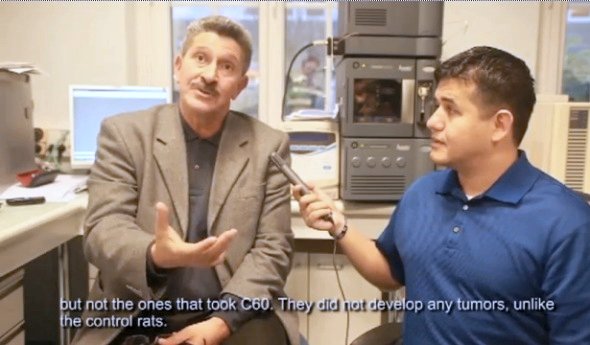
Vidcap taken October 26, 2012. Source: C60.net. No restrictions applied at that time (post #13).
Dr. Moussa has no commerical interest in C60 and holds no C60 patents or C60-related shares.
Normally, Wistar rats die of either pneumonia or tumors. The rats that took C60 in extra virgin olive oil lived nearly twice as long in good health. None of them developed tumors. They kept a normal healthy weight until shortly before they died of generalized organ failure. It is assumed that the rats in the study reached their Hayflick limit.




